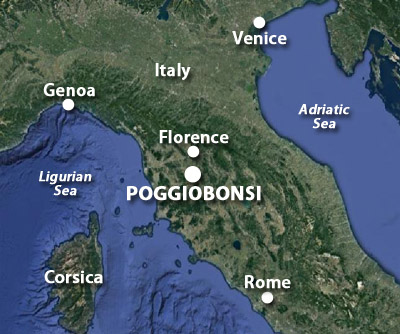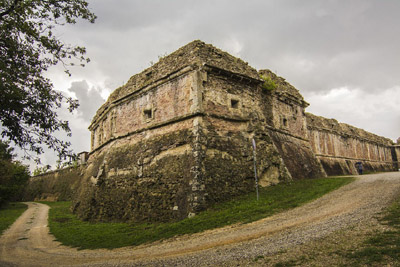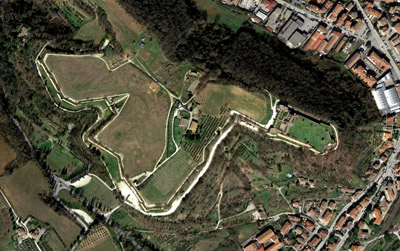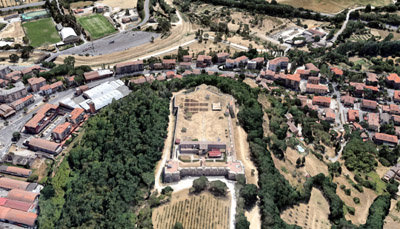 |
Fortezza di Poggio Imperiale
Poggiobonsi, Italy
|
|
 |
Constructed: 1488-1511
Used by: Virtually nobody!
Designed by: Giuliano da Sangallo
Conflicts in which it participated: None
|
With a name like Poggiobonsi, one would expect that at least one of two things came from this town: The pogo stick and/or the bonsai tree. WRONG! The pogo stick was invented in 1920 by a couple of guys in Hanover, Germany, and the bonsai tree came from a Chinese practice called penjing, Chinese for "entertainingly torture a little tree," which originated sometime in the 6th century AD. Long before there were starforts, even in Italy.
But what Poggiobonsi does have is an extremely early starfort, which is way cooler than pogo sticks or bonsai trees. |
 |
 |
|
Folks had been in what is now the Poggiobonsi area since the Neolithic (roughly 10,000BC until 4500 BC), but a medieval-era road from Rome to France was the reason it started developing into a place that needed to be defended, in the 10th century AD. The city was knocked around from owner to owner, and by the end of the 13th century it found itself under Florentine rule: It was known until 1270 as Poggio Bonizio until the Florentines got hold of it, whereupon they razed the city (it was known as the most beautiful city in Italy, but nobody was allowed to be beautifuler than Florence), after which the name became Poggiobonsi.
|
 The Fortezza's northwest bastion: Four centuries and still kickin'. The Fortezza's northwest bastion: Four centuries and still kickin'. |
 |
And if you're talking about Florence at the end of the 15th century (as we now are), you're talking about Lorenzo the Magnificent, better known to those of us who are not Italian as Lorenzo di' Medici (1449-1492). The Medicis were a banking family that became a political dynasty in and around Florence in the 15th century, and were arguably responsible for what we think of today as the Italian Renaissance: Art, music, literature and architecture all flourished in Florence thanks to the financial support of the Medicis...and much more importantly in the context of this website, they may have helped immeasurably in the invention of the starfort! |
|
|
Because the old theories of fortification, based on making higher-and-higher-walled forts from which defenders would dump a steady supply of unpleasant objects and/or fluids onto desperately climbing attackers, were being challenged by the new scourge of artillery. Cannon had been a noisy feature of battlefields since the mid-15th century, but the portability of such early guns was questionable, and it wasn't until France's King Charles VIII (1470-1498) trundled into northern Italy in 1494, with artillery in tow, that such weapons were reliably used in a semi-mobile fashion. Charles and his army of 25,000 men rolled across Italy, capturing and laying waste at their whim, and there was little the Italians could intially do to stop them.
|
Prior to Charles' invasion, however, clever persons recognized the threat that artillery represented to the present form of fortification. The architect Francesco di Giovanni (1425-1495), for some reason known as Francione, was one such person. He and his followers created such proto-starforts as the Fortezza di Sarzanello at the behest of the Medici: Bastioned forts with innovations meant to deal with an artillery-wielding attacker, but he couldn't quite embrace the concept of the triangular bastion... which, as hindsight smugly tells us, was the concept he should have embraced. Military engineers in England were wrestling with the same issue, and came up with similarly interesting, yet ultimately wrong, conclusions: Deal Castle in Kent is an example of this.
|
 |
 The Fortezza di Poggio Imperiale was intended to be the citadel of a walled "ideal city," based on the Poggio Bonizio that was destroyed by the wicked Florentines in 1270. You can still see the outline of much of Poggio Bonizio's walled area today! The Fortezza di Poggio Imperiale was intended to be the citadel of a walled "ideal city," based on the Poggio Bonizio that was destroyed by the wicked Florentines in 1270. You can still see the outline of much of Poggio Bonizio's walled area today! |
|
One of Francione's acolytes was Giuliano da Sangallo (1445-1516). Sangallo learned from the master, but had some ideas of his own regarding fort design. The way to fame and riches in this time at this place was to impress Lorenzo the Magnificent, which Sangallo achieved by building sumptuous palaces and villas in the Florence area. By the 1480's he was the Medici favorite, with enough horsepower to challenge his former master, who clung to the round tower bastions of the medieval castle in his fortification designs. One of Sangallo's early designs was the Fortezza di Sarzana which, though still featuring some unmistakably round tower bastions, also sports a lovely pointy ravelin that would warm the heart of any starfort lover. |
 Poggio Bonizio, presumably before 1270 when the Florentines wiped it off the face of the earth. That tuft of green at center top is where the Fortezza di Poggio Imperiale would be constructed. |
 |
Lorenzo de' Medici envisioned Poggiobonsi as an "ideal city," walled with the new Fortezza affixed on a high point overseeing the town. Work on the Fortezza di Poggio Imperiale had only been underway for four years when Lorenzo the Magnificent had the temerity to pass away from gangrene brought on by an ulcer. Without a noble sponsor paying for everything, work on the Fortezza, and ideal city, skidded to an untimely halt.
The ever-fickle tides of war had also moved away from Poggiobonsi, making a strong fortified presence there unnecessary. While this was indeed sad for the embryonic Forte of our current interest, it had one fantastic side effect: It is, today, essentially as Sangallo intended it to be upon first design. |
|
|
Starforts that were utilized over the centuries were upgraded over the centuries, resulting in a mishmash of styles and eras represented in their construction. This was of course as it should be, an operational starfort was a tool that needed constant upgrade so as to make it able to perform its mission. Not so the Forte di Poggio Imperiale! A few piddling attempts to complete the fort were abandoned in 1513, and some restorations took place from 1634 to 1659, but for the most part our starfort sat unoccupied on its hilltop for 500 years. A nascent interest in its resurrection finally came to fruition at the end of the 20th century, and a series of restoration efforts were completed in 2015.
|
The interior of the fort had been used for farm cultivation for many years, and why not, it's a lovely, wide-open expanse! The fort is dominated by its keep, which is really a four-floored barracks building. One would enter the fort only through the walled city of Poggio Bonizio, which itself was only accessible through five gates.
Today the Fortezza hosts events in the spring and summer, and the keep holds the vast archaeological treasure resulting from many years of excavation at Poggio Bonizio.
|
 |
 The Fortezza majestically watches over Boggiobonsi. The Fortezza majestically watches over Boggiobonsi. |
|
|
|
|
|
|
 |




